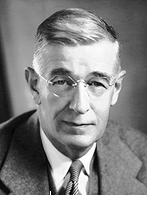Vannevar Bush
Electrical engineer and government official, b. 11 March 1890 (Everett, Mass. USA), d. 28 June 1974 (Belmont, Mass.).
 Vannevar Bush came from a family of sea captains, although his father was a church minister. He received his master's degree in 1913 with a thesis on a machine on two wheels to trace ground contours by pushing it over terrain. He received his doctorate from the Massachusetts Institute of Technology (MIT).
Vannevar Bush came from a family of sea captains, although his father was a church minister. He received his master's degree in 1913 with a thesis on a machine on two wheels to trace ground contours by pushing it over terrain. He received his doctorate from the Massachusetts Institute of Technology (MIT).
Shortly after the foundation of the National Research Council in 1916 Bush approached the Council with a proposal for the detection of submarines. The proposal was accepted, but the device was not successful. After the end of the war Bush joined the electrical engineering department of MIT, where he developed his differential analyzer. He also suggested to the Federal Bureau of Investigation (FBI) capable of reviewing over 1000 fingerprints per minute. The proposal was turned down, but Bush continued to think about information storage and rapid retrieval. His article "As We May Think" published in 1945 described a machine that enhanced human memory by allowing the user to store and retrieve documents linked by associations. The machine, called "memex" by Bush, was based on microfilm technology, but its principle is often seen as the first description of the internet.
In 1937 Bush was appointed president of the prestigious Carnegie Institution of research. In 1940 he presented a plan to President Roosevelt to mobilize military research through the establishment of the National Defense Research Committee (NDRC). As president of the new NDRC Bush channelled the national research activity into military applications. In 1941 he became director of the Office of Scientific Research and Development (OSRD), which subsumed the NDRC. Unlike the NDRC, which had been funded by presidential emergency funds, the OSRD was funded through Congress and had much larger financial means.
Rather than having all military research done through the OSRD Bush contracted research out to academic institutions and industry. By deciding the placement of scientists in institutions the OSRD had a large influence on the structure of universities and other research establishments. One section of the OSRD worked on nuclear fission as the forerunner of the Manhattan Project, and in 1945 Bush recommended to President Truman the use of the atomic bomb on Japanese cities. (Shurkin, 1984)
After World War II Bush was instrumental in adjusting research funding to the new conditions. He called for a National Research Foundation to "develop and promote a national policy for scientific research and scientific education, should support basic research in nonprofit organizations, should develop scientific talent in American youth by means of scholarships and fellowships, and should by contract and otherwise support long-range research on military matters." The National Science Foundation (NSF) was established in 1950.
References
Campbell-Kelly, M. and W. Aspray (1996) Computer; a History of the Information Machine. Basic Books, New York.
Griffin, S. (2000) Vannevar Bush. Internet Pioneers. http://www.ibiblio.org/pioneers/bush.html (accessed 9 September 2004)
Keep, C., T. McLaughlin and R. Parmar (2000) Vannevar Bush. The electronic labyrinth. http://www.iath.virginia.edu/elab/hfl0034.html (accessed 9 September 2004)
Shurkin, J. (1984) Engines of the Mind. W. W. Norton & Company, New York.
home
 Vannevar Bush came from a family of sea captains, although his father was a church minister. He received his master's degree in 1913 with a thesis on a machine on two wheels to trace ground contours by pushing it over terrain. He received his doctorate from the Massachusetts Institute of Technology (MIT).
Vannevar Bush came from a family of sea captains, although his father was a church minister. He received his master's degree in 1913 with a thesis on a machine on two wheels to trace ground contours by pushing it over terrain. He received his doctorate from the Massachusetts Institute of Technology (MIT).